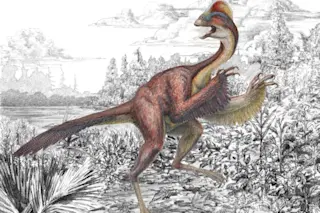The big, bad, beaked stuff of nightmares, new dinosaur Anzu wyliei is described as "hell's chicken" by the researchers who found it. Credit: Mark A. Klingler, Carnegie Museum of Natural History. Researchers announcing a newly described dinosaur called it the "chicken from hell," "hell's chicken" and "scary as well as absurd." More prosaically known as Anzu wyliei, the beaked dinosaur stood about ten feet tall and more than 11 feet long with a tall crest on its head and sharp claws. A. wyliei lived about 66 million years ago in what's now North and South Dakota, possibly sharing the same habitat as the iconic Tyrannosaurus rex and Triceratops species. Researchers announced the new species this week.
Despite its vicious-looking claws, A. wyliei likely ate vegetation, small animals and possibly the eggs of other species. It lived on a floodplain and, while flightless, had a bird-like appearance with slender legs and ...














